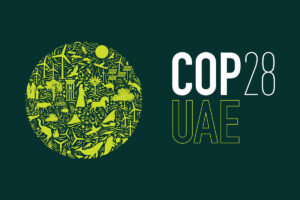What to Watch for Voluntary Carbon and Article 6 at COP 28

Year-end climate talks are focused on the global stock-take, which involves more than just taking stock of past actions. The primary agenda is to create mechanisms for dramatically scaling ambition up for the next five years.
Earlier this month, the government of Rwanda attached a “Letter of Authorization” to carbon credits purchased by German nonprofit Atmosfair. In it, the government agreed to deduct emission reductions from its national greenhouse gas inventory equal to the number of associated credits exported, and to add those emission reductions to the national account of whichever country buys them.
It marks the first time a “corresponding adjustment” has been applied to an individual carbon project under Article 6 of the Paris Agreement – although similar transactions have occurred between countries, such as Peru and Switzerland.
Under Article 6, corresponding adjustments are required for “Internationally Transferred Mitigation Outcomes” (ITMOs), which are emission reductions transferred from one national account to another. That means in the eyes of the UN they are required for compliance transactions but not for voluntary transactions. That’s because compliance credits are, by their very nature, applied to the emission caps of importing countries, although the exporting, or “host,” country, does have the option of requiring them.
What’s on the Agenda This Year at COP?
On paper, this won’t change at year-end climate talks (COP 28) in Dubai. Negotiators have their hands full with the global stocktake (GST) and pressure to chart a roadmap to significantly deeper reductions by 2028.
While calls for more ambitious targets will inevitably turn to talk about the role of markets, the actual agenda items within the negotiating tracks are limited. A big one is the move to create methodologies for carbon removals under Article 6.4, which is governed by the 24-person Article 6.4 Supervisory Body (A6.4 SB).
The A6.4 SB meets throughout the year, and it serves countries that don’t want to develop their own markets and methodologies. This means it is tasked with the complex task of doing so, but its decisions must also be approved at the COP. They submitted guidance for removals in mid-November.
Most activity is expected to take place through Article 6.2, which covers bilateral transactions among countries. That can involve trading national surplus reductions, or linking Emissions Trading Systems (ETSs), which are already regulated. This makes Article 6.2 simpler.
Article 6.4 credits can also be traded via 6.2, but the issuance of new credits under 6.4 could prove challenging.
“There is a risk that methodologies developed under 6.4 will be too political. Specifically that some methodologies will have to be revisited too often, or that credits will be ‘temporary,’ as was the case under the Clean Development Mechanism (CDM),” says Jos Cozijnsen, a former Dutch negotiator now serving as a carbon specialist with the Carbon Neutral Group.
“They may also decide that carbon removals have to be additional to Nationally Determined Contribution (NDC) targets instead of recognized as a tool for meeting NDCs, and this could delay action on removals, where companies invest in a lot these days, and incentivize countries to make less ambitious commitments,” he adds.
COP President Sultan Al Jaber has explicitly stated that “Better-functioning voluntary carbon markets can also channel additional financing to developing countries and support local economies.”
He has pledged to push for “end-to-end” integrity of all carbon transactions, even as UAE-based project developer Blue Carbon inks massive MoUs with African countries and no discernable methodologies. Al Jaber has also called for dramatic reduction in the use of fossil fuels, even as his own country’s negotiating team stands accused of using the event to forge new oil and gas deals.
Beyond the immediate negotiations, the Voluntary Carbon Markets Integrity (VCMI) initiative is contemplating guidance requiring corresponding adjustments on voluntary carbon transactions, although that won’t happen until next year.
Voluntary Demand: Quality is King
Ecosystem Marketplace’s recent State of Voluntary Carbon Markets Report shows that the overall volume of carbon credits transacted have fallen from a 2021 peak – but at the same time, credit prices rose dramatically. Buyers have shifted away from projects perceived as having lower quality and towards those with less uncertainty around emission reductions and more verifiable co-benefits – a good omen for efforts such as Verra’s SD Vista and the Gold Standard for the Global Goals, both of which aim to quantify impacts related to the Sustainable Development Goals (SDGs).
Forests and Markets
Most participants argue that REDD+ (Reduced Emissions from Deforestation and Degradation, plus enhancements of carbon stocks in developing countries) is included in the Paris Agreement, even though the acronym is nowhere to be found. That’s because of two related Articles: Article 5 recognizes the need to cooperate on forest conservation, while Article 6 recognizes the transfer of mitigation outcomes.
The rules for implementing Article 6 weren’t finalized until six years after the landmark Paris Agreement, at COP26 in Glasgow. Sluggish talks at COP27 in Sharm El-Sheikh the following year left key details undefined and open to interpretation. Agreeing on the practical details remains one of the main objectives of COP28.
Beyond the major question of methodologies for removals under Article 6.4, negotiators will consider rules for linking trading systems under 6.2 and nitty gritty issues such as the creation of reporting templates and how countries will submit transactions to the UN for review.
Experts from The Gold Standard says there are already 40 bilateral Memorandums of Understanding (MoUs) under Article 6.2, but only three country-to-country deals have been authorized – all involving Switzerland as a buyer.
Steve Zwick of Bionic Planet is reporting live for Ecosystem Marketplace throughout COP28. Check back for more coverage, and follow EM and Steve (here’s his LinkedIn) on social media.
Please see our Reprint Guidelines for details on republishing our articles.

